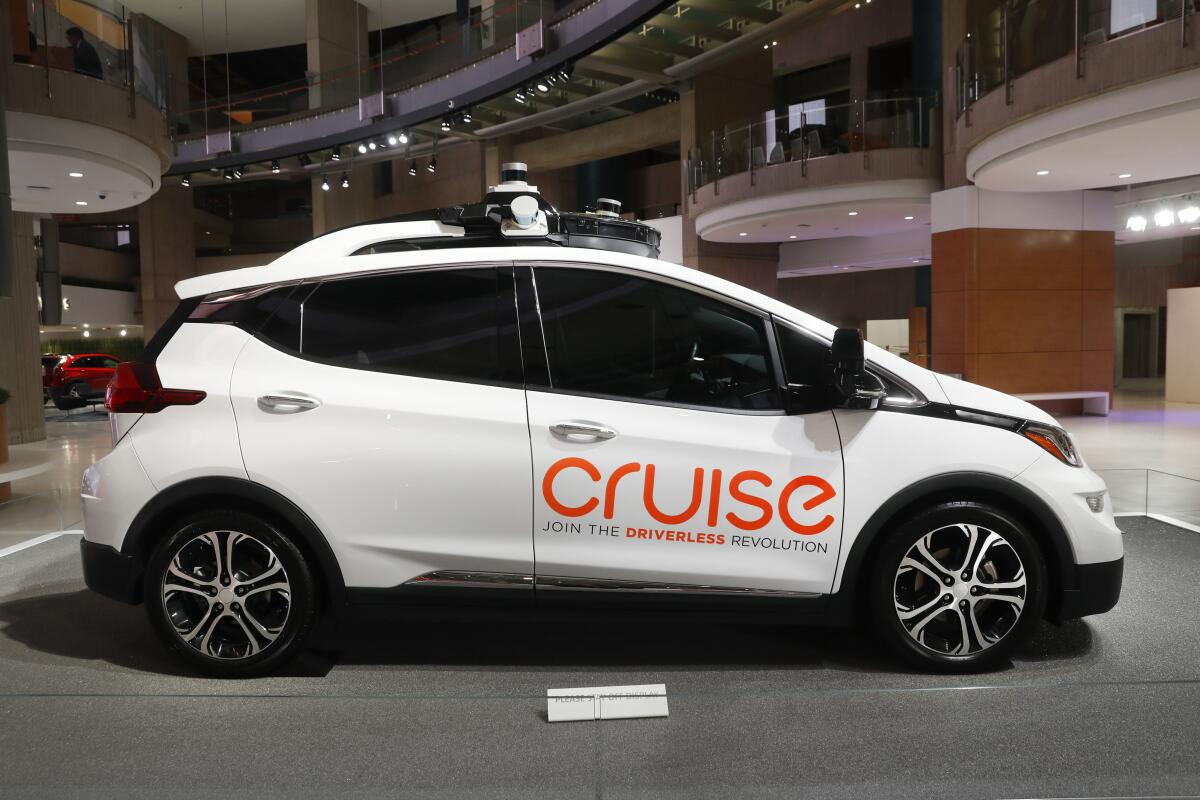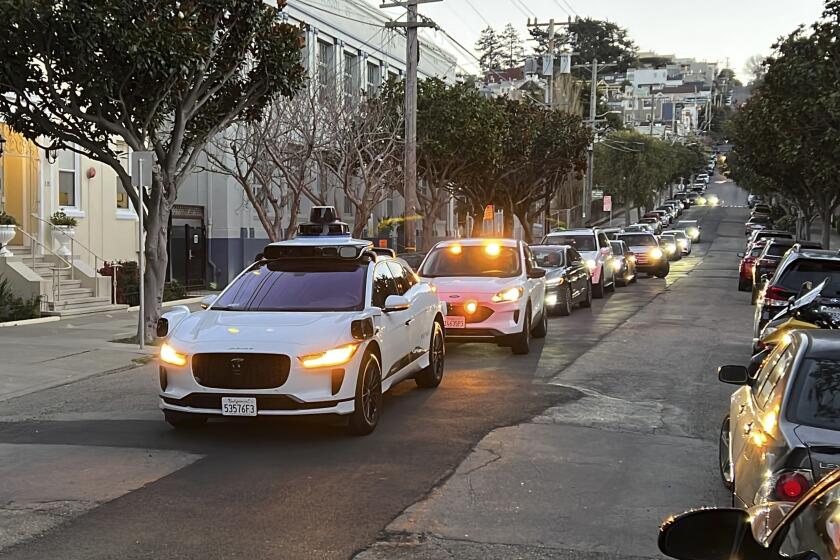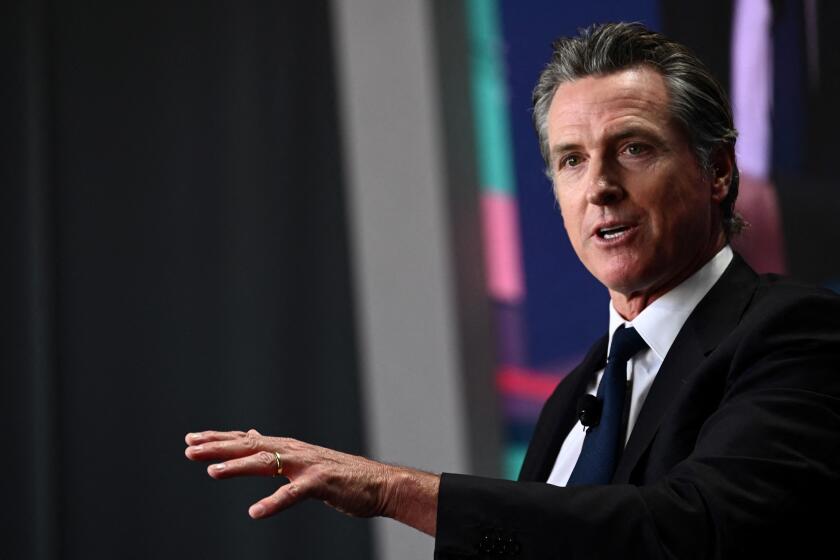California DMV pulls permits for Cruise’s driverless cars over safety concerns

- Share via
Citing public safety concerns about Cruise‘s robotaxi line operating in San Francisco, California DMV officials announced Tuesday that the agency had suspended permits for the driverless cars deployed by General Motors’ autonomous vehicle subsidiary.
Cruise had already been under investigation by federal and state transportation officials after several crashes, some involving pedestrians. In response to the Department of Motor Vehicles’ decision, Cruise pulled its driverless vehicles from the road in California.
“Public safety remains the California DMV’s top priority, and the department’s autonomous vehicle regulations provide a framework to facilitate the safe testing and deployment of this technology on California public roads,” the agency said in a statement. “When there is an unreasonable risk to public safety, the DMV can immediately suspend or revoke permits.”
DMV officials cited violations of state regulations for the suspension, including safety issues based on the vehicles’ performance and safety information that the “manufacturer has misrepresented.” The suspension order said Cruise failed to disclose all the relevant video from an Oct. 2 crash, initially showing only the first part of the crash to investigating state officials — omitting the part in which the Cruise vehicle dragged a pedestrian about 20 feet while pinned underneath the driverless vehicle. Cruise officials, in a statement to The Times, denied that they did not share all of their video with investigators.
Gov. Gavin Newsom’s California Public Utilities Commission on Thursday approved a measure to let robotaxi companies Cruise and Waymo massively expand deployment of their driverless vehicles on San Francisco streets.
DMV officials said that there is no set time frame for a suspension, but that the agency provided Cruise with “the steps needed to apply to reinstate its suspended permits.” It wasn’t immediately clear what those steps would include.
The suspension does not affect Cruise’s permit for testing its autonomous vehicles with a safety driver behind the wheel, according to the DMV.
Cruise officials said in a statement that, after learning about the suspension, it would pause the operation of its driverless vehicles in San Francisco. Cruise also operates robotaxis in Austin, Texas; Houston; Phoenix; Miami; and a few other cities, Cruise spokesperson Navideh Forghani said. She said operations in other regions would not be affected by the California suspension.
“Ultimately, we develop and deploy autonomous vehicles in an effort to save lives,” Forghani said.
The suspension came after the DMV reviewed the Oct. 2 crash , in which a non-Cruise driver first struck a pedestrian, pushing the pedestrian into the path of a Cruise robotaxi. The Cruise vehicle ended up pinning and dragging the pedestrian, causing multiple traumatic injuries, officials said. The other vehicle fled the scene. Cruise said it continues to cooperate with police on the case.
First responders arrived to find a woman pinned underneath a self-driving car with ‘multiple traumatic injuries.’
“The AV [autonomous vehicle] braked aggressively before impact and because it detected a collision, it attempted to pull over to avoid further safety issues,” Forghani said. “When the AV tried to pull over, it continued before coming to a final stop, pulling the pedestrian forward. Our thoughts continue to be with the victim as we hope for a rapid and complete recovery.
“Our teams are currently doing an analysis to identify potential enhancements to the AV’s response to this kind of extremely rare event,” she said.
But there were other incidents that also prompted investigations, including an accident in August when a Cruise vehicle got in the way of a firetruck, causing a crash and injuring the Cruise vehicle’s passenger. The day after that crash, the DMV announced its investigation into the vehicles and said Cruise would roll back the size of its fleet.
First responders in San Francisco have also complained that the autonomous vehicles have repeatedly interfered with emergency vehicles and caused other incidents, especially after the state approved a massive expansion of the cars in August.
This month, one of Cruise’s top competitors, Waymo — owned by Alphabet, Google’s parent company — expanded its driverless vehicles into Los Angeles amid growing concern.
Clashing with the state Legislature and California’s biggest cities over safety, the Newsom administration races ahead with driverless vehicle deployment.
In the midst of Cruise’s suspension announcement Tuesday, labor and city leaders in L.A. and San Francisco rallied outside Cruise and Waymo buildings, calling for an end to what they called “robotaxi mayhem.”
“The rollout of these robotaxis have not worked well in San Francisco, and they’re certainly not going to work here in Los Angeles,” said Lindsay Dougherty, a leader of Teamsters Local 399, a union that represents a variety of drivers. “This is about not just the jobs, but also the safety of our communities.”
The gatherings in both cities questioned Gov. Gavin Newsom’s recent veto of a bill that would have required human safety drivers in heavy autonomous trucks — which aren’t on the road yet but could be soon. Newsom said he trusted the DMV to regulate the rapidly changing industry.
Staff writer Russ Mitchell contributed to this report.
More to Read
Sign up for Essential California
The most important California stories and recommendations in your inbox every morning.
You may occasionally receive promotional content from the Los Angeles Times.














